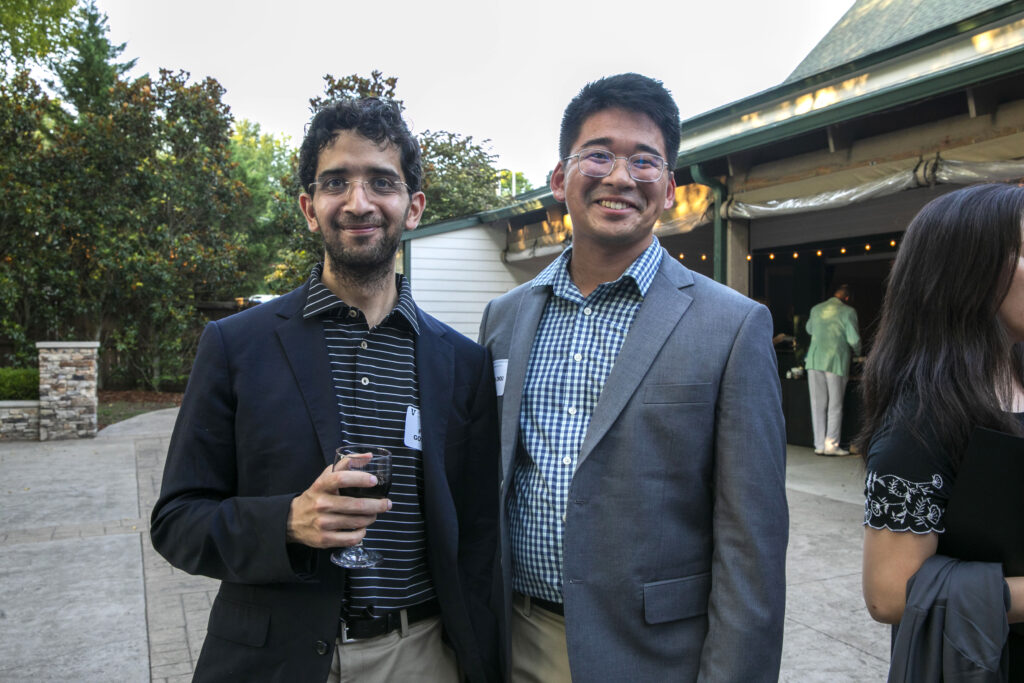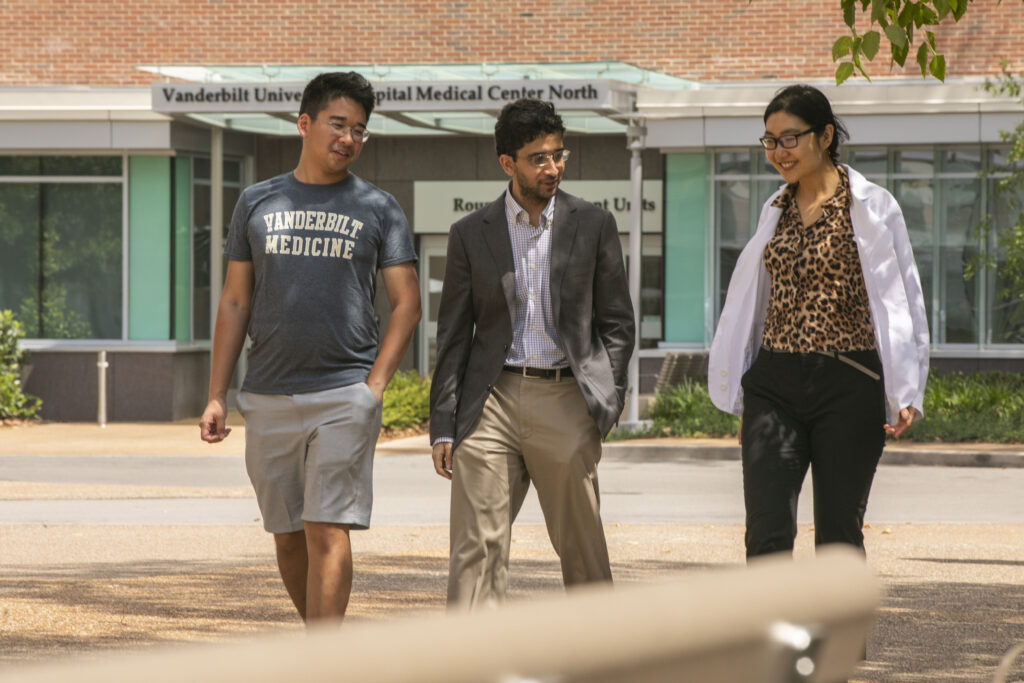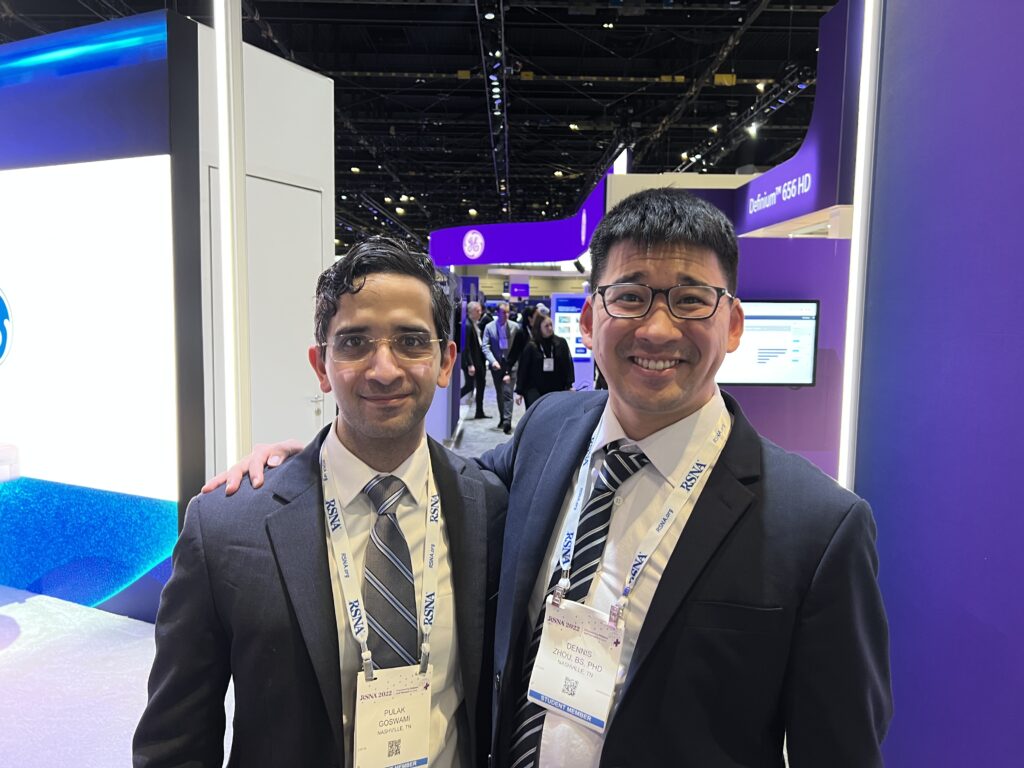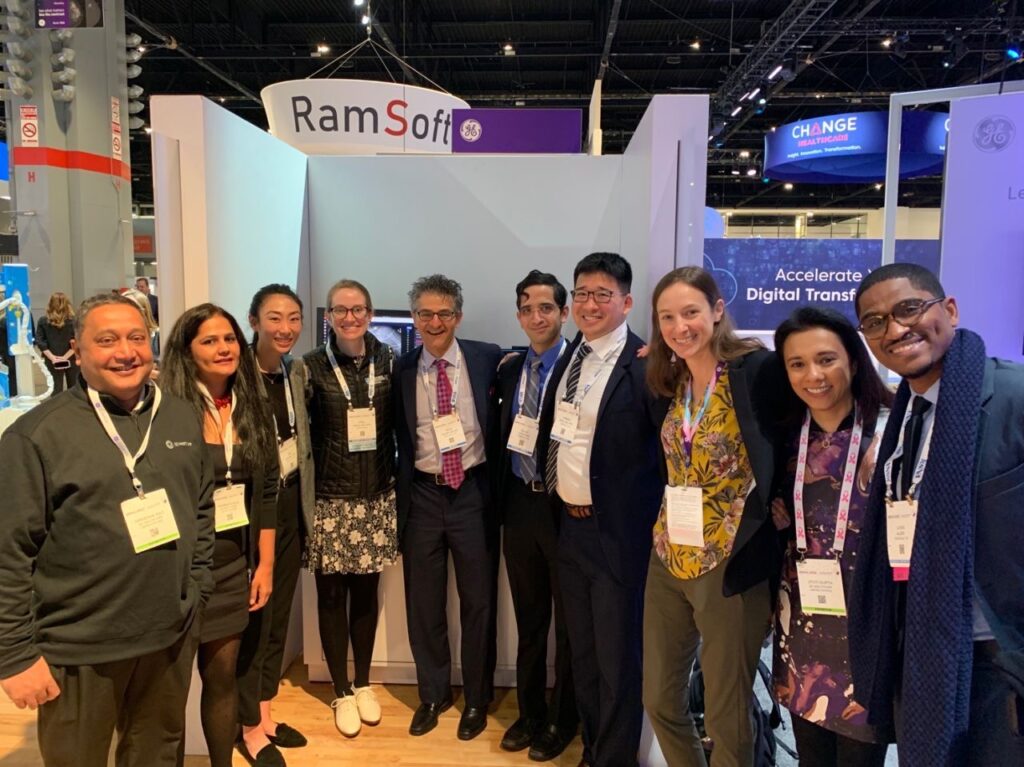A clinical patient encounter led two Medical Innovators Development Program students to develop a potentially life-saving technology through an industry immersion experience with GE HealthCare

By: Lexie Little
The heart monitor beep kept time with an IV pump like the ticking of a clock. More beeps sounded, and still more. Medical Innovators Development Program (MIDP) student Pulak Goswami, PhD, walked into his patient’s intensive care unit (ICU) room early in the morning. His patient, otherwise healthy just months before, had developed complications from an insidious form of liver failure subsequently requiring a transplant. The patient had arrived in the ICU in the middle of the night after a long and complex procedure, not an uncommon occurrence on the hepatobiliary (liver and gallbladder) service.
Every morning on service, Goswami chatted with his patient and his family, hearing about their lives and plans for when this hospital stay would come to an end.
More beeps.
The care team took a routine X-ray when the patient arrived at his room to make sure all was well after the surgery. Looking at his patient, Goswami knew that something was not right. The X-ray had taken some time to be read. That night, like most nights, the Vanderbilt Emergency Department and the covering radiologists stayed busy with traumas and other “routine” X-rays. By the time they had been able to read this patient’s X-rays, the damage had been done.
Medical technology hummed around Goswami, but all he could hear was the conversation he would need to have with his patient rattling in his head.
“Unfortunately, it took hours for the radiologist to read it just because it was overnight,” Goswami said. “As a result of this delay, this patient who was otherwise healthy a few months ago now needed a two week extension on the ICU stay to recover. It was a devastating experience. This was my patient. I went there every morning and talked to this individual. It’s very easy to think about a patient as a number on a piece of paper, but that’s not who they are. They have all these hopes and dreams and a life… It’s difficult to imagine being that dependent on someone else. Living with an indwelling urinary catheter…having all these people coming in all the time – this is a life changing event, and it was made much worse all because of that X-ray being read a little bit later. And this could happen to anybody.”
Goswami witnessed a clinical need and identified questions: How could we make sure that this person’s X-ray gets seen before anybody else so we can avoid this? How could we make this extra two weeks stay become two days or less?
Fortunately, MIDP could provide the answer through a collaboration with GE HealthCare, a global medical technology company.

Innovation in action
MIDP students follow Vanderbilt’s unique MD Curriculum 2.0 path, but they take their learning a step further by combining clinical and didactic education with innovation-centered courses and experiences. Patient encounters during second-year clerkships and individualized immersion help students interested in medical innovation and entrepreneurship identify problems, which they turn into solutions through idea design and technology development in MIDP. Working with faculty and industry leaders, students like Goswami and fourth-year Dennis Zhou, PhD, identify, research, and solve problems directly affecting patients.
“Vanderbilt gives us a ton of early clinical exposure in the second year, which continues in the third year and the fourth year,” Zhou said. “That gives us a lot of time to master clinical skills and gain lots of independent experience taking care of patients. Through these experiences, we see the full scope of clinical problems we may encounter in the hospital and the way they impact patients and clinical teams.”
In the third year of MIDP, students participate in the Innovation Design Experience and Application (IDEA) Lab to solve a health care systems problem. Students take an empathetic approach, interviewing patients and practitioners to identify the most pressing needs in health care. After IDEA Lab, MIDP students participate in industry immersion in their fourth year, where they spend 2-4 months working with an industry partner to learn how new technologies are created and translated to bedside applications within the industry.
Program advisors helped Goswami and Zhou locate their industry immersion with GE HealthCare’s Mobile X-ray team. Starting their immersion project, Goswami and Zhou learned that the Artificial Intelligence (AI) division of this team had deep knowledge of AI algorithms, including algorithms intended to help critical care teams quickly and accurately triage X-rays.

Seeing firsthand the power of the tools already developed by GE, they were reminded of that liver transplant patient.
“The moment we saw what [the GE Team] could do, we knew it was incredible. I repeatedly thought about my patient. What if we could take these tools, modify them a little, and use it to help him?” Goswami said. “It was a very unique project and opportunity for MIDP to send two students to an industry partner and to get to physically be there and work with the team, fully immersed in its day-to-day activity,” Goswami said. “We came up with this specific target based on an actual clinical need that we identified at Vanderbilt and opportunity to align interests with the GE HealthCare team.
“Using the training we received through the MIDP, we conducted customer discovery with both radiologists and medicine floor teams and developed an empathy-based product design. We used our backgrounds, skills from our PhDs, and resources from the incredible team at GE HealthCare to modify existing software and actually make this concept into an early prototype.”
At large hospitals like Vanderbilt University Medical Center, radiology departments might have hundreds of X-rays on the list that come in giant swaths. Radiologists review those images ordered stat, then move to the rest in the order in which they were received. Goswami and Zhou’s new prototype will add to a collection of software solutions offered by GE HealthCare that allows for real time analysis of X-rays using AI. Zhou said the hope is that this AI will help physicians catch issues earlier on so that care teams may address problems for the patient more quickly and prevent further complications from developing.
The MIDP duo annotated images and trained a new artificial intelligence algorithm for the GE HealthCare team. They collaborated with teams in regulation, data science, business, customer discovery, development, design, and production. The prototype AI model joins the roadmap for future AI models in the commercially available Critical Care Suite product, a collection of AI algorithms embedded on GE HealthCare X-ray machines for triage, including pneumothorax detection (collapsed lung) and quantification – such as endotracheal tube positioning, both vital to ICU care.
“We both had a really, really amazing experience over at GE,” Zhou said. “I think GE HealthCare really embraced the new idea that we had and has a culture that prioritizes innovation. “Our supervisors at GE, and the team overall, were enthusiastic about our idea and gave us the encouragement and resources to see if we could achieve this goal. We got to see the whole process, from starting with a new idea, co-designing a proposal with different GE teams, and developing and presenting the prototype at a major radiology conference, the Radiological Society of North America Annual Meeting…[There is such value] in interdisciplinary collaboration between different perspectives like regulatory and business and the potential of industry and academic collaboration to design new medical technologies that benefit patients.”

Impact and reaction
As both students prepare for residency, they reflect on their journeys as medical innovators to this point. Goswami chose Vanderbilt for medical school because of MIDP and its empathetic approach to innovation pioneered by its former director and Chair of the Department of Radiology and Radiologic Sciences, Dr. Reed Omary.
“I picked Vanderbilt because of MIDP,” Goswami said. “There’s no doubt about it. Dr. Omary’s vision for empathy-based innovation was an inspiration for me when I came to Vanderbilt. The MIDP empowered us to use empathy and patient experiences to really find what is needed. The program has given us the tools, certainly, like design thinking, empathy-based interviewing, and consumer development. But it has also given me, specifically, the confidence and the motivation to think, ‘I can actually do this.’ Dr. Omary has this ‘Yes, and’ mentality that I couldn’t find at any other medical school. There was nothing quite like it.
“When Dennis and I were at GE, this attitude that we had about the ‘Yes, and’ mindset that makes MIDP special allowed us to open up this problem and think about it differently [in exploring possible solutions without limiting ourselves]. I think that through the technical skills, this ability to practice empathy-based design, and the attitude of ‘Let’s just do things and see what happens, let’s break things in our minds so we can help patients,’ MIDP has really empowered me to solve problems in the world.”

Zhou echoed his colleague’s sentiments, saying MIDP blazed a trail with its dedication to medical innovation and designing a unique curriculum centered on technology for the future.
Originally designed for those with pre-existing PhDs in basic and applied sciences, the MIDP now welcomes any entering medical student with an interest in medical innovation and entrepreneurship. The program welcomed its first non-PhDs in August 2022.
“To my knowledge, I don’t know of any other medical schools in the country who let medical students gain such firsthand exposure and collaboration with industry professionals,” he said. “For the GE experience specifically, MIDP taught us how to design a solution for a problem we’ve identified. MIDP taught us to visualize the big picture and think about ways we can engage expertise within industry settings and with physicians to come up with the right kind of features and user interface design for the ultimate solution. The PhD gave us a strong technical skills foundation, MIDP taught us how to make an actual product and design features that are going to most benefit physicians and patients.”
And it all started with patients in mind.